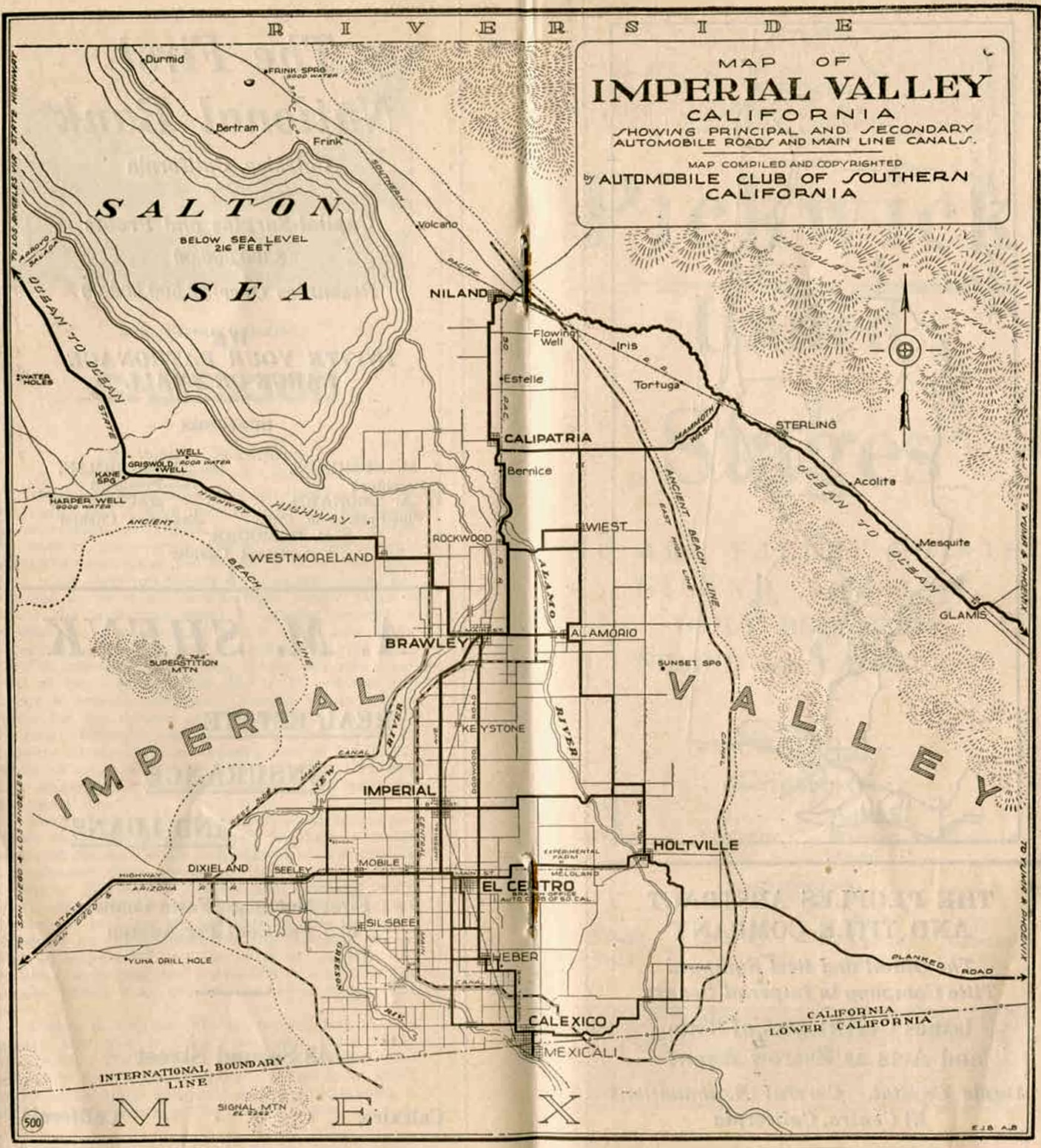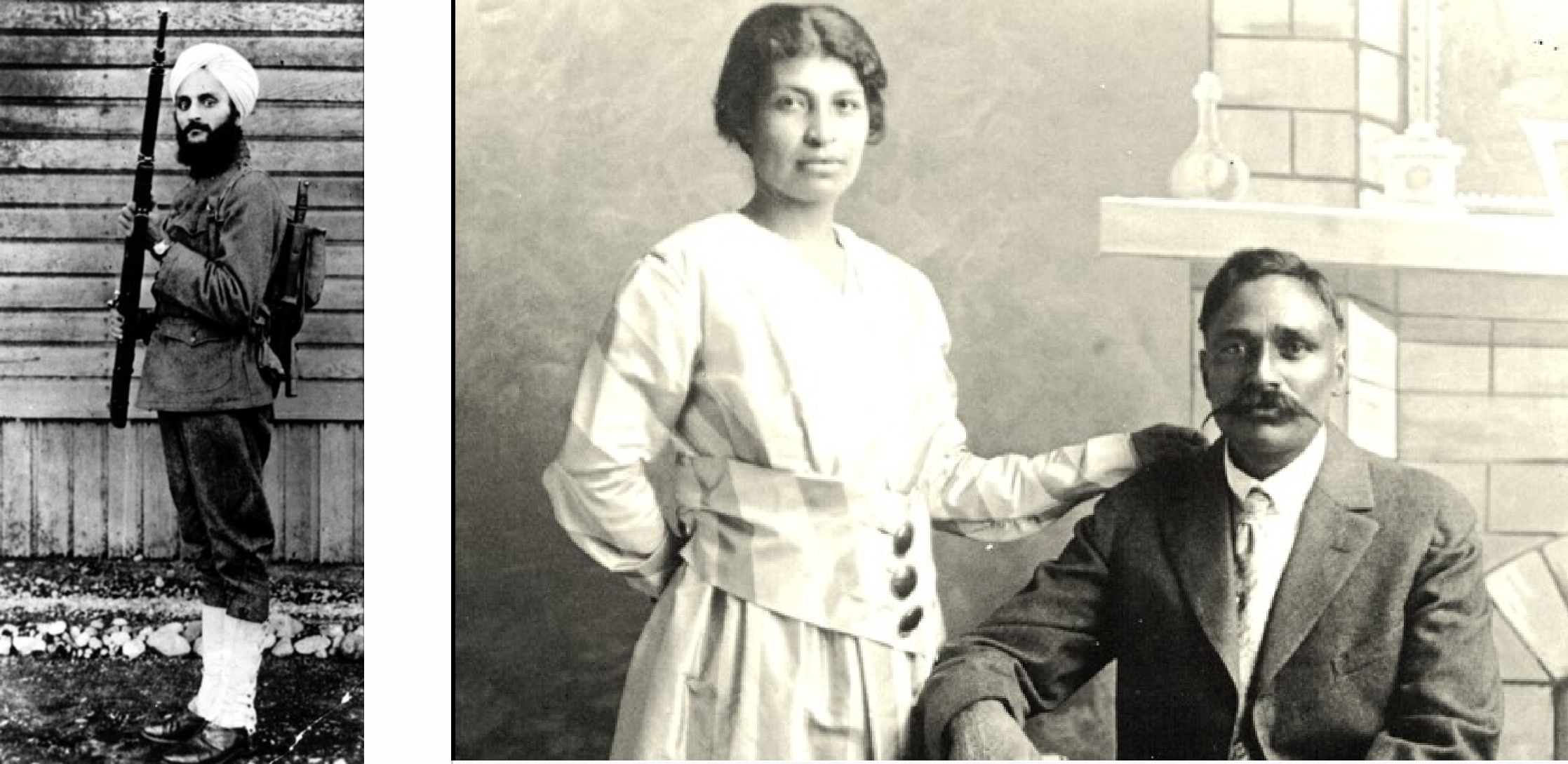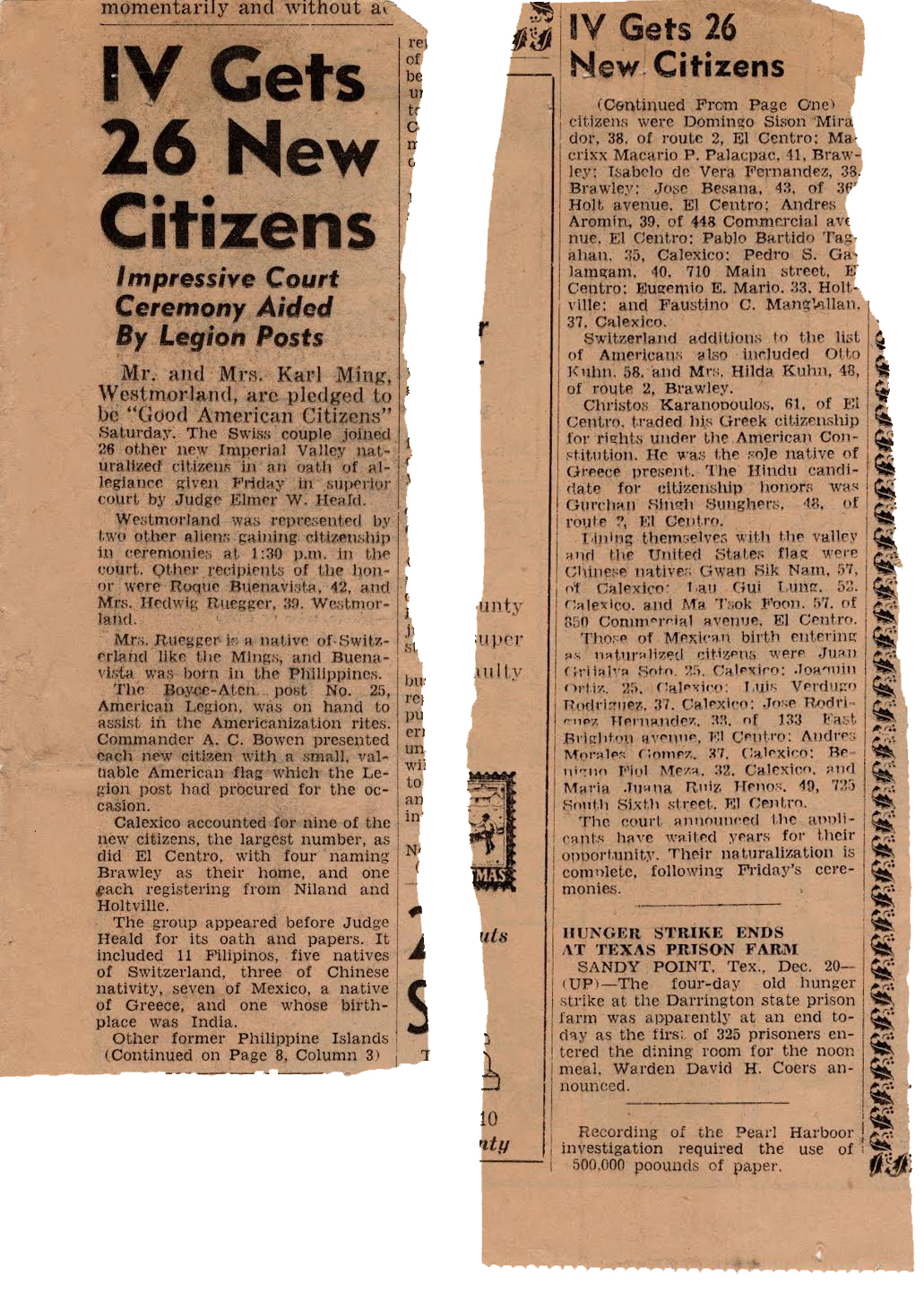Grade: 9-12Subject:
U.S. History, Social Science, English Language Arts Number of Lessons/Activities: 4
Just as Sikh immigrants were beginning to find success as farmers in California’s Imperial Valley (an area bordering between California and Mexico), a series of anti-Asian laws shifted their trajectory. In this lesson, students will trace the history and impacts of the Supreme Court case United States v. Bhagat Singh Thind (1923) and of California’s land laws which prevented noncitizens or more specifically, immigrants of color who were denied citizenship, from owning land. Students will also learn how Sikh immigrants resourcefully responded to these legal challenges and built new communities.
Students will be able to:
- Describe the experiences of Sikh immigrants in the borderlands in the 1900s
- Identify the impact of various anti-Asian legislation that affected Sikh immigrants
- Explain how Sikh immigrants circumvented discriminatory policies and practices
Sikhs in the Borderlands Essay:
Sikh immigrants have lived in the United States since the late 1800s. Most Sikh immigrants came from
Punjab in northern India to work on California farms. Most of California's Sikh population settled in northern California, especially in the Central Valley and Bay Area. In the 1920-30s, Sikh immigrants moved south along the West Coast and had begun making strides in the agricultural industry in California’s
Imperial Valley, which is at the border of the United States and Mexico. With the creation of the
Alamo Canal and later the
All-American Canal, water from the Colorado River was diverted to the dry
Imperial Valley. This water was needed to support agriculture in the Valley. This offered Sikh farmers a chance to establish farms of their own. Because many had experience working in farming in the San Joaquin Valley (and in
Punjab prior to their arrival to
Imperial Valley), many were already familiar with how to grow a variety of crops in these
borderlands.
However, in 1923, the
United States v. Bhagat Singh Thind decision stripped away the opportunity for Sikhs to become growers in their own rights. Because the Thind decision determined South Asians to be “non-white,” Sikhs were now subjected to anti-Asian legislation. They were denied citizenship. In addition, laws such as California’s
Alien Land Law Act of 1913 and 1920 limited their ability to own and lease land. This marked a major shift in many of the farmers' lives.
Resisting U.S. laws, some moved across the U.S.-Mexico border to Mexicali Valley. The Mexicali Valley had a similar landscape. It was also free from California’s restrictive land ownership laws. A
Hindu Colony was established in Mexicali Valley. This colony offered Sikh farmers a home where they could grow crops, seek safety, and put down roots. (There was even an establishment of a small school for children.)
On the other side of the border, in the U.S. Imperial Valley, anti-Asian laws were in full effect. Some resisted by finding
loopholes that circumvented anti-Asian laws. U.S. immigration laws limited Indian women’s immigration and also prevented marriages between Whites and people of color. This meant Sikh men couldn’t marry or establish families. Instead, they formed
bi-racial families with Mexican women instead. Also, anti-Asian laws denied citizenship and land ownership. Instead, Sikh men transferred property rights onto the names of their U.S.-born children. As such, there emerged a creation of a new community: the Punjabi-Mexican American community. The community continued to grow, and a unique culture formed with it.
El Centro is another city in the
Imperial Valley. It was home to a community of Japanese immigrant farmers. After Japan’s attack on Pearl Harbor in 1941, members of the Japanese American community were forcibly and illegally detained in
incarceration camps in the 1940s. They were accused of being security threats. The El Centro Japanese American community were forced to sell their Buddhist Temple building. The Sikh community bought it and used it as a Sikh Temple. In this way, the building could continue to be used as a religious space. A year later in 1947, the
Imperial Valley Sikh community opened the second Sikh Temple in the United States: the El Centro
Gurdwara . Today, the El Centro Sikh Temple continues to serve a diverse population. It still offers safety to those traveling through the
borderlands .
Sikh immigrants have survived and thrived in California’s
borderlands.
Bibliography:
“Bureau Against Orientals in the US.” The Morning Post. July 13, 1943.
“Dhillon is Citizen in Imperial Valley After 20 years.” Imperial Valley Press. June 13, 1947.
El Centro Sikh Temple. “Articles of Incorporation of Imperial Valley Khalsa Diwan Society.” December 14, 1947.
“Imperial Valley Gets 26 New Citizens,” Imperial Valley Press. Date Unknown.
Leonard, Karen. Making Ethnic Choices: California’s Punjabi Mexican Americans. Philadelphia: Temple University Press, 1992.
- Alamo Canal: canal that connected the Colorado River to the Alamo River to provide irrigation to the Imperial Valley; it was replaced by the All-American Canal as Imperial Valley’s water source by 1942 and was also known as Imperial Canal**
- Alien: a term that refers to a foreigner from another country or government; it is generally considered a derogatory and dehumanizing term and has widely been replaced with the term “noncitizen”
- All-American Canal: canal in southeasternmost California transporting water 80 miles from the Colorado River to the Imperial Valley; construction began in the 1930s and by1942, it became the sole water source for Imperial Valley residents and area farmlands**
- Bi-racial: of two different races of people
- Borderlands: a territory at or near the border of two or more countries
- Gurdwara: a Sikh shrine or place of worship
- Hindu: a person who follows Hinduism, a religion practiced in India; in the early U.S., Indians were generally referred to as Hindu
- Imperial Valley: valley in the Colorado Desert in southeastern California
- Incarceration: confinement in a jail or prison
- Loophole: an ambiguity or omission in the text of a law through which the intent of the law may be evaded; a legal escape route
- Punjab: the region of the northwestern Indian subcontinent in Pakistan and northwestern India
- What were the experiences of Sikh immigrants in the borderlands?
- What work did the Sikh immigrants find and why were they suited for such work?
- What was the impact of United States v. Bhagat Singh Thind on Sikh farmers in the Imperial Valley?
- What was the impact of California’s Alien Land Laws on Sikh farmers in the Imperial Valley?
- In what ways are United States v. Bhagat Singh Thind and California’s Alien Land Laws anti-Asian?
- What factors led to the establishment of the Punjabi-Mexican American community in the borderlands?
- What factors led to the opening of the El Centro Gurdwara?
- What is the significance of places like the Hindu Colony and the El Centro Gurdwara?
- What are some challenges of living in borderlands and how were Sikh immigrants prepared for these challenges?
- How did the Sikh farmers circumvent anti-Asian laws?

Map of the Imperial Valley, circa 1915. Imperial Valley is at the southern edge of California and shares a border with Mexico. The map also shows El Centro, the largest city in Imperial Valley.
Credit: Auto Club, Imperial Chamber of Commerce, Wikimedia Commons (Public Domain Image)
Source
Activity 1: Introducing the Borderlands
- Have students complete a Quickwrite responding to the following prompt: “Think of a classroom or school rule/policy. How are you impacted? How are others impacted? Are others impacted in similar or different ways from you? What may account for these differences?”
- Show students a map of Imperial County:
- Zoom in and out to show where in California the Imperial Valley is. Point out its proximity to the United States-Mexico border and where El Centro is. Share that El Centro is the largest city in the Imperial Valley.
- Explain that this region surrounding the United States-Mexico border is informally known as the “borderlands.” Ask students what they think are some of the benefits and challenges of living in the borderlands, or rather, living close to national borders.
- Tell students that agriculture was and continues to be a major industry in the Imperial Valley.
- Tell students that we will learn about how federal and state laws changed the lives of Sikh immigrants living in the borderlands in the 1900s, and how communities of color were resilient and resourceful in the face of anti-Asian legislation.

Agricultural workers in the Imperial Valley, 1941. Many Sikhs immigrants found work in agriculture in the early 1900s in the borderlands.
Credit:
National Archives Collection (Public Domain Image)
Source
Activity 2: Identifying Historical Causation
- Have students read the essay. Consider the following options:
- OPTION 1: Have students read the essay independently either for homework or during class time.
- OPTION 2: Read aloud the essay and model annotating.
- OPTION 3: Have students read aloud in pairs or small groups.
- Facilitate a class discussion by asking students the discussion questions.
- Have students watch the video entitled, “Racial Identity and American Citizenship in the Court" in order to learn more about United States v. Bhagat Singh Thind. Have students discuss what they learned from the video and how it connects to the experience of Sikh immigrants in the borderlands. [Content warning: This video contains mention of suicide.]
- Have students complete the worksheet entitled, “Cause and Effect: United States v. Bhagat Singh Thind (1923).”
- Have students identify factors that led to United States v. Bhagat Singh Thind in the top boxes.
- Have students identify the outcomes that occurred as a result in the bottom boxes.
- Have students complete the worksheet entitled, “Sikhs in the Borderlands: Historical Causation.”
- Have students write a description for each event/development in the table.
- Have students list the causes and effects of each event.
- Have students analyze the relationship among historical causes and effects. Have students consider the way historical events result from a variety of factors by responding to the questions on p. 2 of the worksheet.

Left: Bhagat Singh Thind in U.S. Army uniform in 1918. Thind, a Sikh immigrant, argued that he was eligible for citizenship because he was of the Caucasian race in the Supreme Court case
United States v. Bhagat Singh Thind.
Credit:
Wikimedia Commons (Public Domain Image)
SourceRight: Valentina Alarez and Rullia Singh posing for their wedding photo in 1917. They were among the thousands of Punjabi-Mexican unions that sprouted up in the Southwest of the United States.
Credit:
Wikimedia Commons (Public Domain Image)
Source
Activity 3: Tracing United States v. Bhagat Singh Thind to the Punjabi-Mexican American Community
- Have students complete a primary source analysis of excerpts of United States v. Bhagat Singh Thind.
- Read aloud this instagram posting about Bhicaji Balsara, the first known Indian immigrant to gain U.S. citizenship. Have students summarize the IG carousel in one sentence.
- Distribute the worksheet entitled, “Primary Source Analysis: United States v. Bhagat Singh Thind (1923)” and the text of the Supreme Court case United States v. Bhagat Singh Thind.
- Have students highlight sentences or phrases in the court case that resonate with them or that need clarification.
- Have students summarize the case in their own words.
- Have students complete the Primary Source Analysis worksheet by responding to the prompts and push students to consider source, contextualize, and analyze.
- Have students discuss the following questions with a partner, citing evidence from the court case:
- How does the court define “Caucasian”?
- How does the court invoke science in this case?
- What does the court say about “racial difference”?
- Have students research the Punjabi-Mexican American community.
- Have students watch this video about Punjabi-Mexican families .
- Distribute the worksheet entitled, “Research: Punjabi-Mexican American community” and the two articles entitled, “The early 20th Century was rife with anti-immigrant laws. They spurred a flourishing Punjabi-Mexican community in California " by Yoonji Han and “Punjabi Sikh-Mexican American community fading into history " by Benjamin Gottlieb.
- Have students highlight sentences or phrases that resonate with them or that need clarification.
- Have students document their findings in the worksheet as they read.
- Facilitate a discussion by asking the following questions:
- What were the historical contexts in which the Punjabi-Mexican American community began to form?
- What role did anti-immigrant and anti-Asian sentiments play in forming the Punjabi-Mexican American community?
- How did these communities of color show resilience and resourcefulness?
- Have students examine the connection between the Thind case and the formation of the Punjabi-Mexican American community.
- Facilitate a discussion by asking students: “How is United States v. Bhagat Singh Thind connected to the Punjabi-Mexican American community?”
- Have students work in small groups and visually create a presentation (i.e., flowchart, poster, drawing) of the connection and share with the class.
- Facilitate a discussion by asking students: “How did the Sikh immigrants in the borderlands use community as a tool of resistance? What are other similar historical or contemporary examples of marginalized groups developing community in order to fight for equity and/or social change?”

This newspaper clipping from the Imperial Valley Press (date unknown), entitled “Imperial Valley Gets 26 New Citizens,” lists the names and countries of origin of newly naturalized citizens.
Credit: Courtesy of Dr. Amrit Deol
Activity 4: Analyzing the Experiences of Sikh Immigrants in the Borderlands
- Have students write an essay in response to this prompt: “What were the experiences of Sikh immigrant communities in the borderlands? What were their challenges and how did they respond to these challenges?”
- Distribute the worksheet entitled, “Sikhs in the Borderlands: Essay Planner.”
- Have students outline their thinking on the worksheet.
- Have students write the essay.
- Remind students to cite evidence to support their claims.
- Facilitate a discussion by asking students: “What more do you want to know about the Sikh immigrant communities in the borderlands? How will this information help you gain a more comprehensive understanding of the Sikh American experience in the borderlands?”
- Have students learn about the El Centro Sikh Temple, and find out more about the historical and cultural significance of Gurdwaras in the United States.
- Have students research the 2020-2021 Indian Farmers’ Protest and ask students what connections they see between the protest and the history of Sikhs in the borderlands.
- Have students learn about current issues impacting farmers in the Imperial Valleys and compare and contrast farming in the 1900s to farming today.





